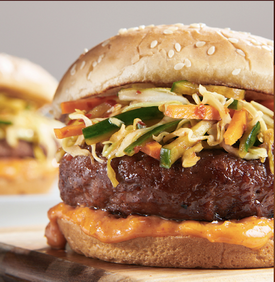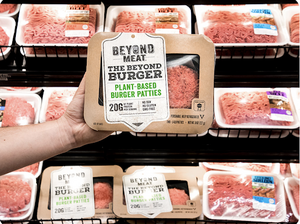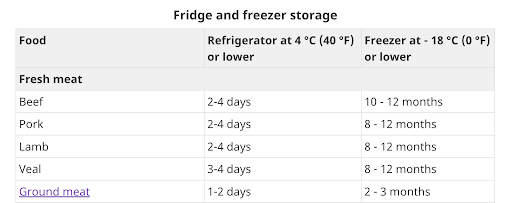Course:FNH200/Projects/2023/Beyond Meat
Beyond Burger Ingredients Explained

Beyond Burgers (BB) are a plant based substitute made to resemble the flavor, texture, and look of beef patties. The following ingredients are found in BB’s - Water, Pea Protein Isolate, Expeller-Pressed Canola Oil, Refined Coconut Oil, Rice Protein, Natural Flavors, Cocoa Butter, Mung Bean Protein, Potato Starch, Apple Extract, Salt, Potassium Chloride, Vinegar, Lemon Juice Concentrate, Sunflower Lecithin, Pomegranate Fruit Powder, Beet Juice Extract[1]. The protein blend is crafted from peas, mung beans, faba beans, and brown rice, ensuring their products are rich in nutrients (i.e. iron) typically found in meat[1]. Coconut oil, cocoa butter, and expeller-pressed canola oil are the fats responsible for the marbled appearance of animal meat, fatty melt in your mouth profile, and plant-based sizzle[2]. The potato starch contributes to the texture by absorbing excess water, thus aiding in binding/shaping the patty[3]. Methylcellulose, a plant fiber derivative, acts as a thickener and an emulsifier aiding in the overall texture[3]. Moreover, lemon juice and vinegar act as a natural preservative that can also be used for its flavour, colour retention, and to lower pH which can influence the texture and stability of the product.
Processing
The manufacturing process is carried out partly internally and partly by third-party co-manufacturers[4]. A technology for altering the structure and presentation of plant proteins is patented by the company. Beyond Meat receives a dry blend comprising pea protein [4]. The pea protein first passes through a thermoplastic extruder, originally developed at the University of Missouri, which employs heat and steam to transform plant proteins into a meat-like fibrous texture reminiscent of muscle fibers[5]. The pea proteins are then woven together by heating, chilling, and application of pressure[4]. Next, the weaved protein is broken into smaller pieces, frozen, and generally shipped to co-manufacturers, who combine it with flavors and other components according to Beyond Meat's formula to create the final product[4]. All manufactured goods are subsequently distributed directly to the desired destination via co-manufacturers.

Packaging

Beyond burgers (BB) are packaged under atmospheric conditions that differ from the normal atmosphere (i.e. different composition of gasses). This packaging technique is called modified atmosphere packaging (MAP) and is used to maintain freshness and extend storage life by preventing the growth of bad and ugly microorganisms. Two 1⁄4 pound BB’s are packaged in a thermoformed polypropylene tray with a polyethylene sealant[6]. The tray consists of polypropylene, a synthetic resin derived from petroleum and is likely used by the manufacturers due to the low cost, ability to safely undergo high heat, resistance to moisture absorption, and durability (protect from physical damage)[7]. The sealant provides product visibility to consumers which may influence their purchasing decision. Each patty sits on wax coated paper and the final product is placed in a paperboard sleeve that is formed from numerous layers of pulp[7]. Although the packaging material may be advantageous for manufacturers, there are sustainability issues. For instance, the packaging contains non-biodegradable single-use plastics, thus making it inefficient in terms of recycling[6]. Additionally, in the total lifecycle of the BB, the packaging is accountable for 33.3% of energy used, creates emissions that are avoidable, and uses 1.64L of water which is triple the amount used to produce the ingredients[7]. However, it is estimated that swapping to a polypropylene tray made completely from post-consumer recycled content will reduce energy use by 10% and emissions by 2%[7].
Storage
Like ground beef, Beyond Burgers should be stored by chilling or freezing. As both products can support the growth of ugly microorganisms, the Food and Drug Regulations of Canada require foods like Beyond Burgers and ground beef to be stored at temperatures of 4 degrees Celsius and below. Cool storage stops the growth of most ugly microorganisms but still allows the growth of psychotropic microorganisms and some bad microorganisms like moulds. However, safe storage only extends the amount of time the food can be safely consumed. The Beyond Meat website recommends to use the product within 3 days of opening or if purchased frozen, consumed within 10 days of thawing the product in a refrigerator.[1] Similarly, Health Canada recommends that ground meat products be consumed from 1-2 days if refrigerated or 2-3 months if frozen.[2] Beyond Meat packaging also says “Do not refreeze” on it. Refreezing this product might negatively affect its taste and/or allow the growth of microorganisms that had reproduced when the product had been previously thawed.[3]

Regulations
Through our research, the regulations for beyond meat have not changed since the latest of guidelines released in December of 2020.
As Beyond Meat products are designed to closely resemble and replace traditional meat products, they are subject to specific regulations within the labeling requirements established by the CFIA. These regulations fall under category two, which pertains to simulated meat products. Simulated meat products are defined as “Any food that does not contain any meat product, poultry product or fish product but that has the appearance of a meat product” .
Labeling regulations dictate that simulated meat products must bear the label 'simulated,' accompanied by a reference to the specific cut or type of meat they imitate. Additionally, these simulated products are required to meet minimum standards for protein and fat content, while also adhering to regulations concerning food additives. The exact protein and fat criteria vary based on the type of product. For instance, ground beef simulations must contain a minimum protein content of 16% and a fat content of no more than 30%, whereas sausages are expected to have 23% protein and 40% fat, respectively [6].
Furthermore, since simulated meat products lack the inherent vitamin composition found in natural meats, they are mandated to be fortified with an assortment of vitamins and essential mineral nutrients, such as iron and vitamin B12. These specific fortification requirements are outlined within the broader framework of food and drug regulations [8].
The guidance provided by the FDIC underscores the regulatory focus on ensuring that Beyond Meat products serve as true substitutes for genuine meat. These regulations are aimed not only at replicating the taste of meat but also replicating its nutritional profile in terms of protein, fat, and other essential nutrients. In essence, Beyond Meat products are meticulously crafted to not only mimic the sensory experience of meat consumption but also to offer comparable nutritional value.
Exam Question
Q: What advantages does Beyond Meat provide when compared to regular ground beef (Select all that apply) :
X provides better nutritional value
✓ accommodates a more diverse range of diets
✓ more environmentally sustainable to produce
X more cost effective to buy
The correct answers are “accommodates a more diverse range of diets” and “more environmentally susta[4]inable to produce”. Beyond Meat provides a meat substitute for people looking to shift away from animal-based protein, while having a lower carbon footprint than ground beef. However, it is not necessarily “healthier” or cheaper.
This question addresses an essential product of modern food science that is relevant to the course material and reflects real-world trends in the food industry. I think that this question encapsulates the most important aspects when comparing the plant-based and animal-based ground meat options from the perspective of a general consumer. I believe it is important to evaluate the exam question from this perspective since many FNH200 students may not find themselves pursuing a career in this field, though it is still valuable information to learn as a consumer. This question also demystifies the assumption that Beyond Meat is “healthier” than regular ground beef; rather, it simply has its nutritional advantages and disadvantages.
References
- ↑ "Beyond Burger". Beyond Meat. Retrieved August 6, 2023.
- ↑ "Safe food storage". Government of Canada. July 5, 2021.
- ↑ Cudmore, Dale (June 3, 2022). "Does Beyond Meat Go Bad?". VegFAQs.
- ↑ Verzegnassi, A. "Beyond the meat: Plant-based meat alternatives and their market, a focus on beyond meat" (PDF).
- ↑ "Government of Canada, C. F. I. A. (2022, July 6). Government of Canada. Canadian Food Inspection Agency". https://inspection.canada.ca/food-labels/labelling/industry/meat-and-poultry-products/eng/1632494849908/1632495277194?chap=19#c19. Check date values in:
|date=(help) - ↑ "Agency, C. F. I. (2020, November 3). Government of Canada launches consultation on guidelines for simulated meat and poultry products . Canada.ca".